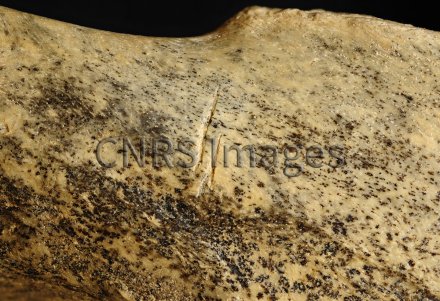Production year
2009

© Hugues PLISSON/CNRS Images
20110001_1006
Traces de découpe laissées par un tranchant lithique, sur une mandibule d'ours brun découverte sur le site moustérien de Byzovaya au nord de la Russie, près de la ville de Petchora. La culture moustérienne, qui s'est développée au Paléolithique moyen (-300 000 à -33 000 ans), se distingue par l'utilisation d'une gamme très diversifiée d'outils sur éclats, principalement par l'Homme de Néandertal en Eurasie, mais aussi par l'Homme moderne au Proche-Orient. Les vestiges retrouvés sur ce site ont été datés de 28 500 ans, soit plus de 8 000 ans après la disparition théorique de l'Homme de Néandertal. L'Homme de Néandertal aurait-il vécu plus longtemps que l'on ne croyait ? Ou bien l'Homme moderne aurait-il migré en Europe dès le Paléolithique moyen ?
The use of media visible on the CNRS Images Platform can be granted on request. Any reproduction or representation is forbidden without prior authorization from CNRS Images (except for resources under Creative Commons license).
No modification of an image may be made without the prior consent of CNRS Images.
No use of an image for advertising purposes or distribution to a third party may be made without the prior agreement of CNRS Images.
For more information, please consult our general conditions
2009
Our work is guided by the way scientists question the world around them and we translate their research into images to help people to understand the world better and to awaken their curiosity and wonderment.